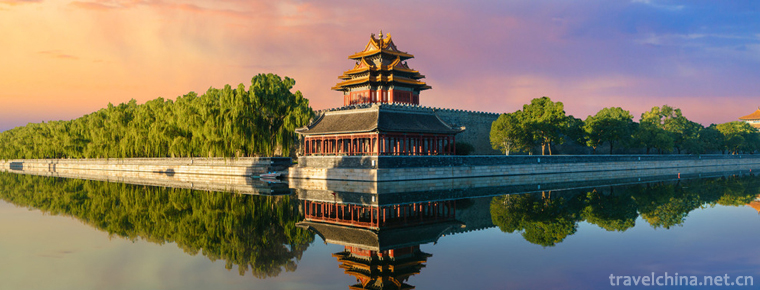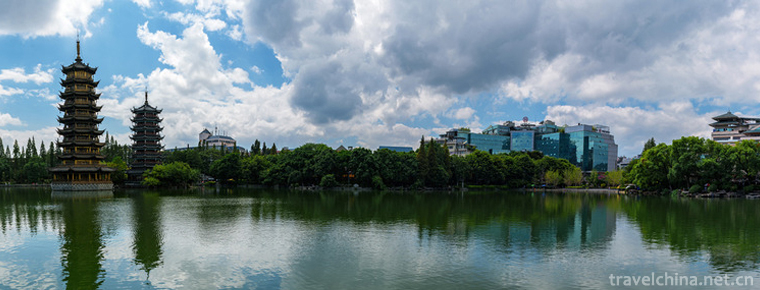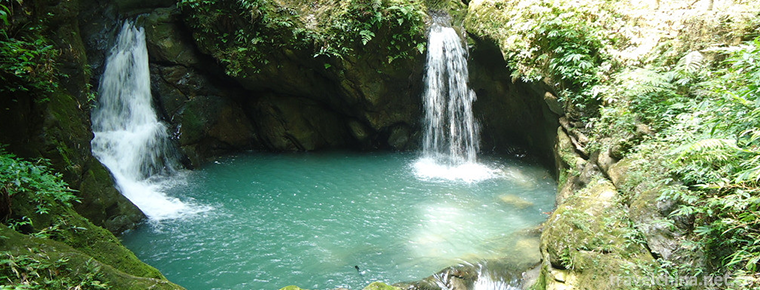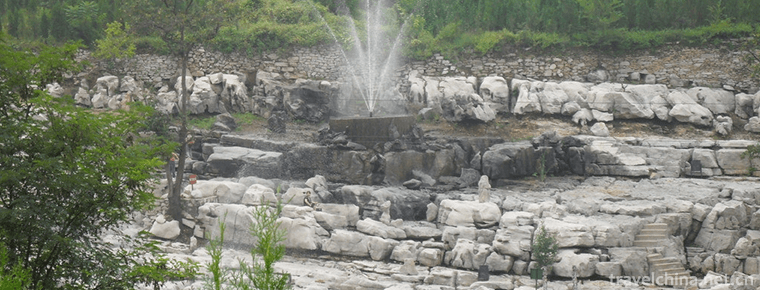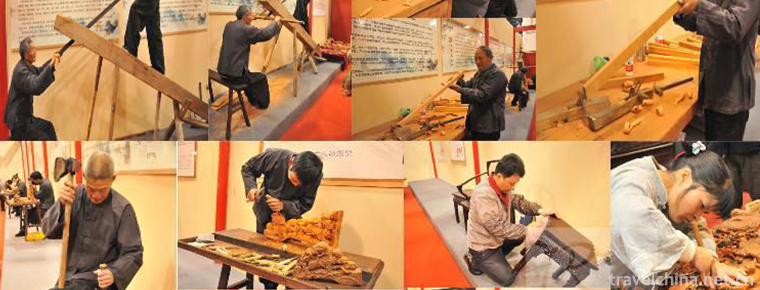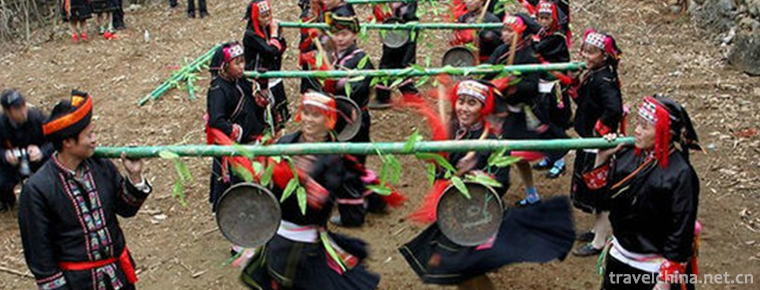Construction Techniques of Traditional Architecture of Xiangshan Band
Construction Techniques of Traditional Architecture of Xiangshan Band
Xiangshan Gang's traditional architectural construction techniques, local traditional handicraft techniques in Suzhou City, Jiangsu Province, one of the national intangible cultural heritage.
The traditional architectural techniques of the Xiangshan Band originated in the Spring and Autumn Period and the Warring States Period, formed in the Han and Jin Dynasties, developed in the Tang and Song Dynasties, and flourished in the Ming and Qing Dynasties. After the founding of New China, the traditional craft of Xiangshan Band's classical architecture has been inherited and developed rapidly.
On May 20, 2006, the traditional architectural construction techniques of Xiangshan Band were approved by the State Council of the People's Republic of China and listed in the first batch of national intangible cultural heritage list, project number: _-27. On September 28, 2009, at the 4th meeting of the UNESCO Intergovernmental Committee for the Protection of Intangible Cultural Heritage, the traditional construction techniques of the Xiangshan Gang in Suzhou were selected as the construction techniques of traditional wooden structures into the world intangible cultural heritage.
historical origin
Xiangshan Gang is a school of architecture with a long history and inheritance of more than 2500 years. It originated in the Spring and Autumn Period and the Warring States Period, formed in the Han and Jin Dynasties, developed in the Tang and Song Dynasties, flourished in the Ming and Qing Dynasties, and declined in the Republic of China. Beijing Forbidden City, Tian'anmen, Suzhou Gardens and other world-famous and exquisite world cultural heritages are outstanding representatives of Quxiang and Yao Chengzu, who use superb architectural skills to write a glorious chapter in the history of Chinese architecture.
"Southern Dynasty 480 temples, how many buildings in the smoke and rain. "The highly developed Buddhist and Taoist culture in Suzhou has promoted the development of Xiangshan Band architecture from another level and region.
For hundreds of years, Suzhou craftsmen have been known for their expertise in sophisticated and elaborate traditional Chinese architectural techniques. The designer of Tiananmen Gate, Quxiang, was also born here. He was respected as the ancestor of the Xiangshan Band because of his excellent architectural skills. In the centuries of inheritance, the Xiangshan Gang has also emerged a number of generations of artisans who have been handed down from generation to generation.
Early Xiangshan craftsmen were mainly woodworkers and hydraulics. Wood carving was managed by woodworkers and brick carving by masonry craftsmen. After Ming and Qing Dynasties, with the increasingly delicate and cumbersome style of architectural sculpture and the increasing demand for business, the division of labor of Xiangshan craftsmen has been developing towards specialization. Xiangshan Band has gradually formed a large group of carpenters of wood, mud, brick, wood, stone, paints and other kinds of construction.
In 1979, in order to inherit and develop the traditional craftsmanship of Xiangshan Band's classical architecture, more than 60 skilled craftsmen of Xiangshan Band were assembled and Wuxian Ancient Architectural Craftsmanship Company was established. Later, more than a thousand fragrant mountain craftsmen gathered under their leadership.
Technological characteristics
Xiangshan Gang's traditional architectural construction technology is known as the outstanding representative of Soviet architecture. It integrates architectural technology with architectural art and is an important school of Chinese ancient architecture industry. The architectural skills of the Xiangshan Band, adhering to the construction method of traditional Chinese architecture in civil engineering, have strong local characteristics, while in architectural decoration, they are good at wood carving, brick carving and color painting in the Soviet style.
Xiangshan craftsmen have excellent woodcarving technology, and have always been in line with Jinhua and Dongyang Woodcarving in Zhejiang Province. Brick carving has been widely used and developed in Suzhou residential buildings. The brick carvings of Xiangshan craftsmen are famous for their winding and powerful lines, vivid and vivid images, gentle and elegant styles, auspicious patterns, elegant and vulgar tastes, and free and easy knife techniques.
The group of construction craftsmen in Xiangshan Band not only has a complete range of work, but also has a fine division of labor, which can meet the needs of high-difficulty construction technology. For example, carpenters are divided into "big wood" and "small wood". Damu is engaged in building beams, beams, purlins, rafters, rafters, eaves, warping angle and so on. Small wood for door panels, hanging, window panes, floor covers, railings, partitions and other building decoration. Among the small woodworks, there were special carving crafts (after the Qing Dynasty, there were special carvers in woodworking). Apart from the fine division of labor, the tools of the Xiangshan Band are also very advanced. For example, carpenter chisels are divided into five types: chisel, round chisel, warping chisel, butterfly chisel and triangular chisel. Each chisel has several chisels of different sizes or angles.
The architecture of Xiangshan Band has the characteristics of harmonious tone, compact structure, exquisite manufacture and changeable layout. It can be said that the technology is exquisite, enjoys the world's fame, handed down from generation to generation. Huqiu "Broken Beam Hall" construction technology uses the Bodhisattva roof, chessboard grid, Pipa hanging, bucket arch and other techniques. Although the two buttresses are connected, they are still very strong, reflecting the characteristics of Xiangshan Band architecture: rectangular frame system, the configuration of each component and the connection between the components are wood and wood, its stiffness depends on the combination of mortise and tenon, not one nail and one iron. It is exquisite and beautiful, but also very stable.
The architecture of Xiangshan Band has the characteristics of harmonious tone, compact structure, exquisite manufacture and changeable layout. It can be said that the technology is exquisite, enjoys the world's fame, handed down from generation to generation. Xiangshan Gang is the product of Wu culture, and many masters have emerged in history, such as Shaping Saint Yang Huizhi, Quxiang and Yao Chengzu. Quxiang presided over the construction of the three palaces of the Ming Dynasty, Tiananmen Gate and the six ministries of the imperial palace. He invented and created the "Diamond Leg" and was praised as "Quluban" by the Emperor of the Xianzong. Yao Chengzu's handed down works include the Lotus Root Champs in Yiyuan, the Daxiong Palace in Lingyanshan Temple, and the Plum Blossom Pavilion in Xiangxuehai. His greatest achievement is to compose "Creating Fayuan", a monograph describing the traditional techniques of Xiangshan Gang, which is praised by the Chinese people as "the Treasure Book of Chinese Soviet architecture".
Inheritance and Protection
Inheritance value
Cultural Value
The cultural value of Xiangshan Gang's traditional architectural construction lies in its rooting in Wu culture, sucking the nutrition of Wudi Buddhism and Taoism culture, and bearing the distinct imprint of Wu culture. It is a people-oriented green building system that adds color to the environment.
artistic value
The artistic value of the traditional architecture construction techniques of the Xiangshan Gang lies in that it embodies the highest achievement of the architecture in southern Jiangsu, and makes the gardens of Suzhou become an artistic model combining practicality and aesthetics. Its architecture is people-oriented, elegant and concise in the late Ming and early Qing Dynasties, vigorous and heavy in the Qianlong and Jiaqing periods of the Qing Dynasty, and exquisite and gorgeous after Tongzhi Guangxu period.
Heritage figures
Xue Fuxin, male, was born in September 1928. In June 2007, Xue Fuxin was selected as the representative successor of the first batch of national intangible cultural heritage projects and declared in Suzhou, Jiangsu Province. Project Name: Traditional architecture construction techniques of Xiangshan Band.
Lu Yaozu, male, was born in April 1949. In June 2007, Lu Yaozu was selected as the representative successor of the first batch of national intangible cultural heritage projects and declared in Suzhou, Jiangsu Province. Project Name: Traditional architecture construction techniques of Xiangshan Band.
Xue Lingen, male, on May 8, 2018, Xue Lingen was selected as the representative successor of the fifth batch of national intangible cultural heritage projects and declared in Suzhou, Jiangsu Province. Project Name: Traditional architecture construction techniques of Xiangshan Band.
protective measures
Suzhou attaches great importance to the protection of the traditional building techniques of the Xiangshan Band. In recent years, a comprehensive survey of the traditional building techniques of the Xiangshan Band and its traditional building techniques has been carried out, and textbooks for the building techniques of the Xiangshan Band in primary and secondary schools have been compiled. A list of skilled craftsmen of the building techniques of the Xiangshan Band has been established, and certificates of the contemporary skilled craftsmen have been issued. To carry out in-depth theoretical research on the construction techniques of Xiangshan Band and compile and publish the theoretical collection of the construction techniques of Xiangshan Band; to begin construction of a 380-mu Xiangshan Band Architectural Museum, Qulu Square, Handicraft Workshop Area, Production Area, Research and Development Base of Ancient Garden Buildings, and Binjiang Gardening Area. ” An electronic website has been set up, a special issue has been published, and skills training has been carried out. Xue Fuxin, the first group of representative inheritors of intangible cultural heritage in Jiangsu Province, carried out activities such as inheritance of skills.
social influence
Important Exhibitions
On June 15, 2007, the second Suzhou Forum on the Protection of China's Intangible Cultural Heritage was opened in Suzhou, in which the traditional architectural techniques of the Xiangshan Gang were displayed.
On October 29, 2016, the first "Su Composition Creation Summit" in Wuzhong District was held in Taihu International Conference Center, in which the traditional architectural techniques of Xiangshan Gang were displayed.
From October 29 to November 2, 2018, the 3rd Asia-Pacific Conference of World Heritage City Organization was held in Suzhou, in which the traditional architectural techniques of Xiangshan Gang were displayed.
Representative Works
Wood carving: There is a three-dimensional carving of gingko wood in the clumsy political garden, such as "Pine, bamboo, plum and magpie flying hood".
Brick carving: There are Rui Lantang Gateway in Dongshan, Suzhou, etc.
Stone carvings: There are Stone House of Jingjian Temple in Tianchi Mountain, Suzhou, Stone Tower of Ten Thousand Buddhas, etc.
Painting boutique: There are paintings of Ningde Hall in Dongshan, Suzhou, Changshu Coloured Clothes Hall and so on.
Palace Architecture: Beijing Palace Museum, Ming Dynasty Imperial Mausoleum, Taiping Heavenly Kingdom Zhongwangfu, etc.
Landscape Architecture: Zhuozheng Garden, Liuyuan Garden, Netmaster Garden, Embroidery Garden, etc.
Residential Buildings: There are Tianguanfang Luzhai, Bachelor Street, Suzhou, Dongshan Sculpture Building, etc.
Temple Architecture: There are Xiyuan Temple, Huqiu Pagoda and Xuanmiaoguan in Suzhou.
Overseas Architecture: Mingxuan, New York, Lansu Garden, Portland, Vancouver Garden, Canada, etc.

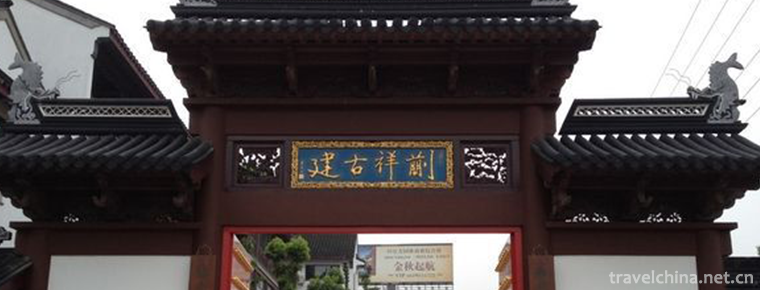
-
Guilin two rivers and four lakes
Guilin's "two rivers and four lakes" refer to the Lijiang River.
Views: 154 Time 2018-10-12 -
Black Valley Scenic Area
Black Valley, National AAAAA Tourist Scenic Spot, National Forest Park, National Geopark, China's Best Leisure Mountain, China's Best Green Low Carbon Tourist Leisure Spot.
Views: 142 Time 2018-12-12 -
Wang Wu Mountain Scenic Spot
Wangwushan Scenic Area is a national AAAA-level scenic area with a total area of 265 square kilometers. Wang Wu Mountain is centered on the Temple of Heaven, the main peak.
Views: 255 Time 2019-02-22 -
Kaiyuan Cave Tourist Area Zibo
The karst cave in Kaiyuan is named for the cliff stone carvings in Kaiyuan period of Tang Dynasty. It is large and tall with a length of more than 1100 meters. It is divided into six halls. The natura.
Views: 126 Time 2019-03-21 -
Steamed egg with sand
Steamed eggs with ginseng sand is a traditional Chinese medicine, which has the effect of invigorating qi, nourishing blood and soothing the mind..
Views: 158 Time 2019-03-24 -
Grass grass drums and drums
Grass gongs and drums, also known as grass chants, are commonly known as "hilarious songs". It is a unique form of folk song art. It is a kind of Tujia folk song that the .
Views: 131 Time 2019-05-02 -
Furniture Making Skills
Ming-style furniture making skills, local traditional handicraft in Suzhou City, Jiangsu Province, one of the national intangible cultural heritage..
Views: 193 Time 2019-05-05 -
Min Opera Fujian Opera
Fujian Opera is the only existing opera that sings and reads Bai in Fuzhou dialect. It is prevalent in central Fujian, Eastern Fujian and Northern Fujian, and spread to Taiwan and Southeast Asia. It i.
Views: 147 Time 2019-06-05 -
Golden Gong dance of Yao nationality
In November 2014, the Golden Gong dance of Yao nationality declared by Tiandong County of Guangxi Zhuang Autonomous Region was listed in the fourth batch of national intangible cultural heritage list .
Views: 221 Time 2019-07-11 -
Southwest Petroleum University
Southwest Petroleum University is a petroleum undergraduate college founded in the face of the new China's Chaoyang. It is a co-established University between the central and local governments, mainly.
Views: 166 Time 2019-08-31 -
Liushi Manorial Museum
Dayi Liushi manoral museum is located at No.15, Jingui street, Anren Town, Dayi County, Chengdu City, Sichuan Province. It is one of the important historical sites and representative buildings in modern China..
Views: 186 Time 2020-11-05
